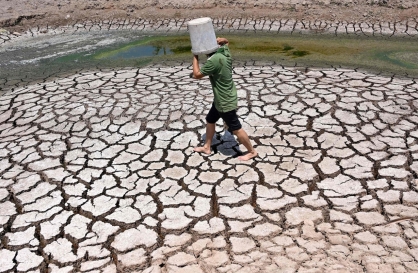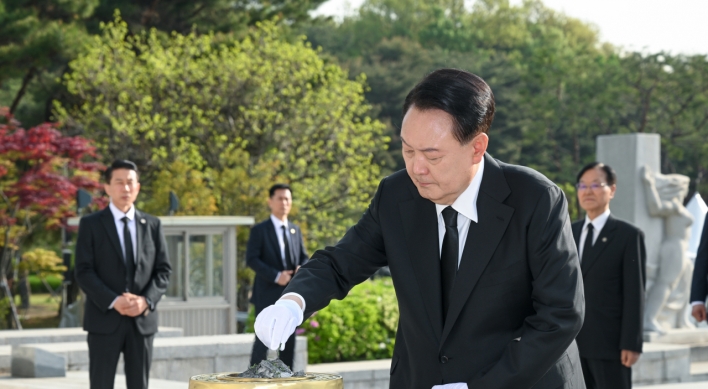About 10,000 more abortions than usual were carried out in Europe when the Chernobyl power plant exploded in 1986.
“The decisions were made not because of their possible exposure to high levels of radiation, but because of the excessive atomic scare,” said Lee Jae-ki, nuclear engineering professor at Hanyang University and member of the International Commission on Radiological Protection.
“There is a saying ‘Curiosity kills.’ Such an overreaction ended up with thousands of invisible victims,” Lee said, warning against the current fear about the impact of Japan’s ongoing nuclear crisis.
For many Koreans, it was a shock that Japan, which may be best-prepared county for earthquakes in the world, was left vulnerable by a massive earthquake and tsunami two weeks ago.
Now their concerns are turning to possible radiation emissions from their closest neighbor.
Jointly hosted by Korea Radioisotope Association and Korean Science Reporters Association, an academic conference was held Thursday to counter groundless rumors among the public.
And the experts made it clear that “there is no possibility that nuclear explosions in Japan would have a serious impact on Koreans.”
For better a understanding, Lee cited the case of Sweden, which is located some 1,000 kilometers away from the Chernobyl plant -― a similar distance between Korea and the Fukushima plant.
According to Lee, a study by the Swedish government found that its people on average were exposed to 0.2 micro sievert after the disaster.
“The amount was not a meaningful increase considering that Swedish people are exposed to more than 6 micro sievert naturally per year,” Lee said.
Despite the modest impact found later, the first response in Sweden was confusing and the people got excessively panicked, Lee said.
“They killed and buried 63,000 reindeers in which relatively high levels of radiations were detected. However, now a pervasive opinion is that the response was excessive.”
The principal elements that have been released from reactors at Fukushima Daiichi plant are iodine 131 and cesium 137.
Cesium is long-lived and travels easily through the food chain, while iodine is much shorter lived but concentrates in the thyroid gland.
However, experts said it is unlikely that serious contamination is detected in Korea.
The government has been monitoring radiation levels of travelers in major airports and sea ports since May 17. Of the 39,958 tested as of Tuesday, small amount of radiation was detected only in 10 people.
The monitoring detectors installed nationwide have also shown no abnormal levels here.
There is also a concern about the Korean government’s lack of potassium iodine and “Prussian blue,” the medicines controlling the level of radioactive iodine and cesium in body.
“The government has secured a stock of medicines to respond to the fifth-level nuclear disaster as defined by the International Nuclear Event Scale. The current stockpiles are for initial emergency response not for treatment of general patients,” said Lee Seung-sook, director of the National Radiation Emergency Medical Center.
“I think the national reserve seems enough for now. But if we are to strengthen our preparedness (for higher level of disaster), more discussions are needed together with academics and government officials,” she said.
With shelves being swept empty of radiation-sickness tablets globally, experts also advised not to hastily take the medicines.
“Some people consider Prussian Blue a panacea. But its consumption is recommended when the radiation levels exceed 100 micro sievert in body. If a person whose radiation levels are not high enough consumes the medicine, it could cause (unnecessary) side effects,” Lee said.
The medical center director also said that no case of medicine consumption have yet to be reported even in quake victims in Japan.
“They may have enough stockpiles of the medicines. However, they are carefully prescribing them only for factory workers and relief workers who are likely to face higher risks,” she added.
Food items from Japan prompt another atomic scare. But experts also said that for now the government’s surveillance system is properly screening imports.
“Japan is effectively screening their export products. And the Korean food agency has tightened its surveillance on all food items from Japan,” said Park Sun-hee, director of food standards at the Korea Food and Drug Administration.
The Korean government has set the radiation limits in foods to stand at 5 percent of the natural exposure level, she said. Korean officials have started an inspection on all products from Japan, not only from the nation’s quake-hit regions, and those passing through Japan since March 19.
The food agency said no contamination case has been found, adding that some 25 food items imported between March 14-23 had been manufactured before March 9 when the double disaster hit Japan.
Despite import bans imposed by the United States and other countries recently, the Korean government was not considering the measure for now, Park said.
“The trade volume between Korea and Japan is much larger than in other countries. We should be more careful about the import ban,” she said.
By Lee Ji-yoon (jylee@heraldcorp.com)
“The decisions were made not because of their possible exposure to high levels of radiation, but because of the excessive atomic scare,” said Lee Jae-ki, nuclear engineering professor at Hanyang University and member of the International Commission on Radiological Protection.
“There is a saying ‘Curiosity kills.’ Such an overreaction ended up with thousands of invisible victims,” Lee said, warning against the current fear about the impact of Japan’s ongoing nuclear crisis.
For many Koreans, it was a shock that Japan, which may be best-prepared county for earthquakes in the world, was left vulnerable by a massive earthquake and tsunami two weeks ago.
Now their concerns are turning to possible radiation emissions from their closest neighbor.
Jointly hosted by Korea Radioisotope Association and Korean Science Reporters Association, an academic conference was held Thursday to counter groundless rumors among the public.
And the experts made it clear that “there is no possibility that nuclear explosions in Japan would have a serious impact on Koreans.”
For better a understanding, Lee cited the case of Sweden, which is located some 1,000 kilometers away from the Chernobyl plant -― a similar distance between Korea and the Fukushima plant.
According to Lee, a study by the Swedish government found that its people on average were exposed to 0.2 micro sievert after the disaster.
“The amount was not a meaningful increase considering that Swedish people are exposed to more than 6 micro sievert naturally per year,” Lee said.
Despite the modest impact found later, the first response in Sweden was confusing and the people got excessively panicked, Lee said.
“They killed and buried 63,000 reindeers in which relatively high levels of radiations were detected. However, now a pervasive opinion is that the response was excessive.”
The principal elements that have been released from reactors at Fukushima Daiichi plant are iodine 131 and cesium 137.
Cesium is long-lived and travels easily through the food chain, while iodine is much shorter lived but concentrates in the thyroid gland.
However, experts said it is unlikely that serious contamination is detected in Korea.
The government has been monitoring radiation levels of travelers in major airports and sea ports since May 17. Of the 39,958 tested as of Tuesday, small amount of radiation was detected only in 10 people.
The monitoring detectors installed nationwide have also shown no abnormal levels here.
There is also a concern about the Korean government’s lack of potassium iodine and “Prussian blue,” the medicines controlling the level of radioactive iodine and cesium in body.
“The government has secured a stock of medicines to respond to the fifth-level nuclear disaster as defined by the International Nuclear Event Scale. The current stockpiles are for initial emergency response not for treatment of general patients,” said Lee Seung-sook, director of the National Radiation Emergency Medical Center.
“I think the national reserve seems enough for now. But if we are to strengthen our preparedness (for higher level of disaster), more discussions are needed together with academics and government officials,” she said.
With shelves being swept empty of radiation-sickness tablets globally, experts also advised not to hastily take the medicines.
“Some people consider Prussian Blue a panacea. But its consumption is recommended when the radiation levels exceed 100 micro sievert in body. If a person whose radiation levels are not high enough consumes the medicine, it could cause (unnecessary) side effects,” Lee said.
The medical center director also said that no case of medicine consumption have yet to be reported even in quake victims in Japan.
“They may have enough stockpiles of the medicines. However, they are carefully prescribing them only for factory workers and relief workers who are likely to face higher risks,” she added.
Food items from Japan prompt another atomic scare. But experts also said that for now the government’s surveillance system is properly screening imports.
“Japan is effectively screening their export products. And the Korean food agency has tightened its surveillance on all food items from Japan,” said Park Sun-hee, director of food standards at the Korea Food and Drug Administration.
The Korean government has set the radiation limits in foods to stand at 5 percent of the natural exposure level, she said. Korean officials have started an inspection on all products from Japan, not only from the nation’s quake-hit regions, and those passing through Japan since March 19.
The food agency said no contamination case has been found, adding that some 25 food items imported between March 14-23 had been manufactured before March 9 when the double disaster hit Japan.
Despite import bans imposed by the United States and other countries recently, the Korean government was not considering the measure for now, Park said.
“The trade volume between Korea and Japan is much larger than in other countries. We should be more careful about the import ban,” she said.
By Lee Ji-yoon (jylee@heraldcorp.com)








![[KH Explains] Hyundai's full hybrid edge to pay off amid slow transition to pure EVs](http://res.heraldm.com/phpwas/restmb_idxmake.php?idx=644&simg=/content/image/2024/04/18/20240418050645_0.jpg&u=20240419100350)






![[From the Scene] Monks, Buddhists hail return of remains of Buddhas](http://res.heraldm.com/phpwas/restmb_idxmake.php?idx=652&simg=/content/image/2024/04/19/20240419050617_0.jpg&u=20240419175937)

![[KH Explains] Hyundai's full hybrid edge to pay off amid slow transition to pure EVs](http://res.heraldm.com/phpwas/restmb_idxmake.php?idx=652&simg=/content/image/2024/04/18/20240418050645_0.jpg&u=20240419100350)

![[Today’s K-pop] Illit drops debut single remix](http://res.heraldm.com/phpwas/restmb_idxmake.php?idx=642&simg=/content/image/2024/04/19/20240419050612_0.jpg&u=)